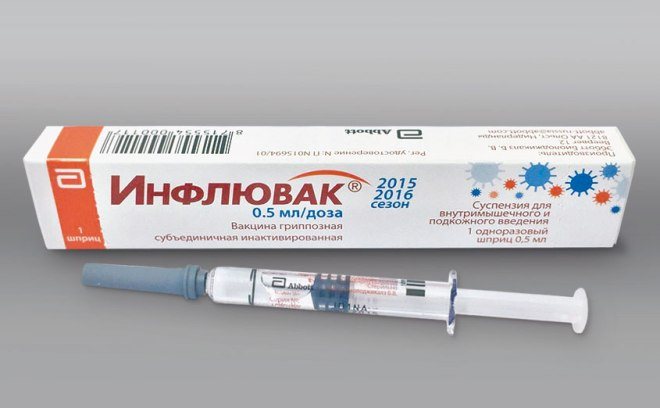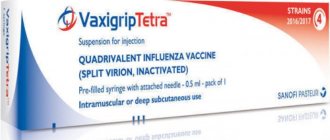It has been clinically proven that vaccination is the most effective and reliable way to prevent diseases in the population. Most often these days you hear about vaccination against influenza strains, which are becoming more and more numerous every year.
Vaccines are created from raw materials that undergo a series of safety tests. Every year the list of provided drugs is reviewed and updated by the Ministry of Health.
Vaccine manufacturers annually rely on guidelines from the World Health Organization. Its laboratories predict which strains will be relevant for the coming season based on which virus serotypes were common last year and by modeling their likely mutations in the next year. If the predictions turn out to be correct, persistent specific immunity will be developed; if not, then nonspecific prevention will help strengthen the body’s defenses, which will reduce the likelihood of infection, prevent serious complications and eliminate death. Strengthening the immune system is also necessary because a weakened body becomes less resistant not only to viral, but also to bacterial infections (for example, measles or diphtheria).
And although constant flu vaccination does not provide guaranteed protection against infection, it can still prevent outbreaks of the disease throughout the country. If a person does get sick, the disease proceeds in a milder form. This is explained by the fact that the vaccine promotes the development of immunity to certain strains, the antigens of which are contained in it. Despite the fact that cross-immunity to influenza viruses is not formed, T-lymphocytes, macrophages and other participants in the fight against hostile microorganisms during the immunization process remember the behavior pattern, and subsequently it will be easier for them to fight new viruses.
At the moment, Influvac or Vaxigrip are considered the most effective and safe flu vaccines, which will be discussed in this article.
Pharmacodynamics and pharmacokinetics
Pharmacodynamics
vaccine is an inactivated vaccine containing purified surface antigens of the most current strains of influenza A and B viruses. According to WHO , its antigenic composition is updated annually.
A single vaccination in adults results in the development of protective antibodies in 95% of patients. Specific immunity appears after 14 days and lasts up to 1 year. The vaccine is approved by the Russian Ministry of Health for the prevention of influenza in Russia.
Since adults are immune to circulating viruses, they are vaccinated once, and children 2 times at intervals of a month. All age groups should be vaccinated annually because influenza are highly variable and the vaccine provides short-term protection.
Pharmacokinetics
Data not provided.
Description of the drug Influvac
In order to decide which is better: Influvac or Vaxigrip, you need to know key information about each of these vaccines. The first is available in the form of a suspension, which is injected under the skin or into muscle tissue. The drug is sold in separate syringes that are easily thrown away after use.
The main aspect of considering any vaccine is, of course, its composition. In the case of Influvac it is as follows:
- Hemagglutinin and enzyme of strains A(H3N2), A(H1N1) and B.
- Additional components include water, sodium phosphate dihydrate, magnesium chloride, potassium and some other substances.
This drug must be used once a year, in the autumn. Its dosage varies depending on the age of the person. If a child is older than six months, but is not yet three years old, then he is entitled to 0.25 ml of vaccine.
Further, up to fourteen years of age, as well as adults who require vaccination, 0.5 ml is administered. The situation changes somewhat if Influvac is given to a child for the first time. In order to strengthen immunity to the flu, you will have to repeat the injection a month later.
Influvac, instructions for use (Method and dosage)
The vaccine is administered intramuscularly; subcutaneous administration is possible. The dose for adults is 0.5 ml, which is administered once. Persons with immunodeficiency are administered twice with an interval of a month. For children - 0.25 ml (6 months-3 years) and 0.5 ml (3-14 years) once. For those who have not previously been sick or vaccinated, it is administered twice at an interval of a month.
Before administration, warm the drug to room temperature, shake the syringe well, remove the cap and remove air from the syringe. During vaccination, it is necessary to have anti-shock medications. Immunization is carried out in the fall.
Which flu vaccine is better: Influvac or Vaxgripp. Comparing the active component
In order to say which of the vaccines is most effective, we will need to look at their composition in more detail. Vaxigrip and Influvac must be compared according to the following criteria: composition, effectiveness, manufacturer and adverse reactions.
Both vaccines are inactivated (that is, killed, not live). This means that they do not contain living microorganisms.
The drug Influvac belongs to the third generation of anti-influenza drugs, or subunit vaccines. This means that it consists of surface proteins (antigens of the virus), so such drugs very rarely give unwanted reactions.

The drug Influfak as an active component contains hemagglutinin and neuraminidase of strains A (H3N2), A (H1N1) and B. The following substances are added to the product from the accompanying components:
- purified water;
- sodium dihydrate;
- magnesium chloride;
- potassium.
Influvac is available in the form of a suspension for subcutaneous and intramuscular administration.
The dose of the drug is calculated based on the patient’s age and weight. For children from 6 months to 3 years of age, Influfak is administered in a dosage of 0.25 ml, for children over 3 years of age and adults - 0.5 ml. Experts say that to strengthen immunity to influenza, it is necessary to re-administer the vaccine after 1 month.
Vaxigrip is a second generation drug. Such formulations are split vaccines, which means that all parts of the virus are completely removed from them, unlike whole-virion vaccines. Only proteins from the outer and inner shells are present as active substances.
In terms of its active ingredient, Vaxigrip is similar to the Influvac vaccine. It is also based on hemagglutinin and enzymes of strains A (H3N2), A (H1N1) and B. The only differences can be found in the fact that Influvac contains only proteins from the virus shell, while Vaxigrip also contains internal ones.
The drugs also differ in the list of auxiliary components. Instead of sodium dihydrate, sodium chloride is added to Vaxigrip.
Vaxigrip is also available in ampoules and is intended for subcutaneous or intramuscular administration.
The dose of the drug for children from 6 months to 3 years is 0.25 ml, for adults and children over 3 years old - 0.5 ml. For persons who have problems with immunity, the drug is re-administered at intervals of 1 month.

Reviews about Influvac
Vaccination is recognized by domestic and foreign researchers as the leading means of preventing influenza. First of all, because it significantly reduces the spread of infection and reduces the number of severe complications. This vaccine has been produced since 1950. The company constantly monitors its quality. Extensive application experience confirms the presence of a favorable safety profile. Clinical studies on this subject are conducted every year and serious adverse reactions are monitored and analyzed.
Every 5 years, the company publishes a review devoted to the experience of its use, and over all the years it has been concluded that the vaccine has weak reactogenicity and does not cause significant adverse reactions. It is subunit vaccines , being a modern generation, that have good immunogenicity and weak reactogenicity.
Influvac is characterized by fairly high rates of anti-epidemic and preventive protection. Even if vaccinated people get the flu, it is mild and without complications. All these points are reflected in the reviews.
- “... We do influvac for the flu with the whole family every year. There have never been any reactions, I think that the effect is obvious - everyone at work had the flu (some milder, some more severe) except me.”
- “... We make it for ourselves and our child every year. Everything is fine, no reactions.”
- “... We are getting vaccinated as a family. We don’t get the flu.”
- “... I’ve been vaccinating my daughter every year for 10 years now, and I’ve never had the flu. The youngest son was treated for 2 years in a row - there was no flu or severe ARVI either.”
- “... I did it for children, but I didn’t feel any difference - they still hurt.”
Which vaccine is better tolerated: Influvac or Vaxigrip. Side effects after vaccination
In order to understand which vaccine is better tolerated, it is necessary to list the adverse reactions that a person may experience after vaccination with both vaccines.
During the vaccination process using the drug Influvac, a person may experience undesirable manifestations. Reactions to this vaccine most often occur in the nervous system. The main ones include:
- feeling of numbness in the limbs;
- encephalomyelitis;
- headache;
- neuralgia.
In addition, the most common symptoms include:
- joint pain;
- myalgia if muscle tissue was affected;
- increased body temperature;
- malaise, chills;
- allergic reactions;
- compaction at the injection site;
- increased sweating.

Possible adverse reactions to the administration of the Vaxigrip vaccine:
- headache;
- neuralgia;
- encephalomyelitis;
- allergic manifestations;
- prostration;
- flu-like syndrome;
- compaction at the injection site.
As you can note, the side effects are completely the same, with the exception of a few points.
It is impossible to definitively answer which vaccine is better tolerated, since their composition is almost identical. It remains to compare vaccines based on other fundamental characteristics.
Prevention of influenza (epidemic season 2017-2018)
Home → Children's department → Vaccination room → Prevention of influenza (2017-2018 epidemic season)
Influenza is one of the most common viral diseases that affects the upper and lower respiratory tract. Influenza is characterized by severe intoxication, severe complications and can be fatal.
Risk groups for influenza include:
- children under two years of age whose immunity has not yet fully developed;
- aged people;
- people suffering from chronic diseases, incl. persons with congenital and acquired immunodeficiency conditions, oncological, immune and endocrine diseases;
- persons who come into contact with a large number of people due to the nature of their profession (doctors, teachers, salespeople, etc.);
- pregnant women and women in labor. In 2014 According to the order of the Ministry of Health, for the first time pregnant women are included in the list of categories of the population for whom flu vaccination is recommended. This is due not only to the severe course of the disease during pregnancy, but also to the pathological effect of the virus itself on the fetus.
Complications that may occur with influenza:
- pneumonia;
- otitis media, sinusitis, sinusitis, bronchitis;
- meningitis, encephalitis;
- infectious-toxic shock;
- glomerulonephritis.
Death from influenza is possible due to:
- intoxication;
- development of pneumonia;
- hemorrhages in the brain;
- heart failure.
Every year in Russia several million people fall ill with influenza. The period of occurrence of influenza “outbreaks” and epidemics is from November to March.
The most effective preventive measure against influenza is vaccination. Currently, there are a large number of both domestic and imported vaccines against influenza. Vaccines annually include those variants of influenza viruses recommended by the World Health Organization (WHO). These recommendations are based on careful analysis of information about the viruses that cause influenza and their circulation. The agreement between recommended options over the past 20 years is more than 90%.
The vaccines do not differ in the influenza virus variants they contain. They differ in:
- species (live and inactivated).
- method of administration (subcutaneous, intramuscular, intranasal). The most effective is intramuscular administration of the drug due to better absorption.
- to the manufacturer.
For adults, inactivated split vaccines are recommended, which contain only part of the virus and have fewer side effects.
For children, inactivated subunit vaccines are recommended - highly purified, with virtually no side effects.
When vaccinated, the virus contained in the vaccine is introduced into the body, which provokes the body to produce antibodies. Antibodies prevent viruses from multiplying and further infecting body cells, which makes it possible to prevent the disease. Immunity to the influenza virus is formed no earlier than 7-14 days after vaccination. In people who have previously been vaccinated, immunity may develop slightly faster. The vaccine provides protection against the virus for up to 1 year.
It is advisable to carry out anti-influenza immunoprophylaxis in advance, therefore the most favorable period for mass immunization of the population is considered to be the period from October to December.
Vaccination against influenza can reduce the incidence rate by 1.5-2 times. In addition, the flu vaccine helps prevent severe complications, reduces the severity of the disease itself, and avoids deaths in vaccinated people who become ill.
Comparative characteristics of vaccines
| Vaccine | Manufacturer | Dosage | Method of administration | View |
| Ultravac | Russia | One time | Intranasally | Live |
| Grippol plus | Russia | Once/Twice (according to indications) | Intramuscular/Subcutaneous | Inactivated subunit |
| Ultrix | Russia | One time | Intramuscularly | Inactivated split vaccine |
| Grippovac | Russia | Twice (for nasal administration) / Once | Intranasal/Subcutaneous | Inactivated whole |
| Influvac | Netherlands | Once/Twice (according to indications) | Intramuscular/Subcutaneous | Inactivated subunit |
| Fluarix | Belgium | Once/Twice (according to indications) | Intramuscular/Subcutaneous | Inactivated split vaccine |
| Vaxigrip | France | Once/Twice (according to indications) | Intramuscular/Subcutaneous | Inactivated split vaccine |
| Fluvaxin | China | Once/Twice (according to indications) | Intramuscular/Subcutaneous | Inactivated split vaccine |
The cost of vaccination against influenza at the Nizhny Novgorod medical clinic is from 490 rubles, depending on the vaccine chosen. The price includes a preliminary consultation with a doctor.
Which is better Influvac or Vaxigripp?
What should you look for when considering such similar vaccines? It is difficult to know which is better: Influvac or Vaxigrip, if they are almost the same. Both drugs are actively used in Russian-speaking countries and give the same results, but all this does not prevent people from asking pharmacists every year what to choose.
Some are repelled by the fact that Vaxigrip has slightly fewer side effects, but only by 1-2 points. Moreover, where can there be a serious difference in impact, given the same composition? This leaves only one aspect to pay attention to.
Influvac and Vaxigrip have different prices. If the first one usually costs about 500-600 rubles, then the price of the second one, as a rule, is around 400 rubles . If we add to this the dubious claim that Vaxigrip has fewer side effects, then the choice in its favor will become obvious.










